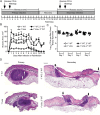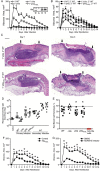Targeting Staphylococcus aureus α-toxin as a novel approach to reduce severity of recurrent skin and soft-tissue infections
- PMID: 24740631
- PMCID: PMC4207862
- DOI: 10.1093/infdis/jiu223
Targeting Staphylococcus aureus α-toxin as a novel approach to reduce severity of recurrent skin and soft-tissue infections
Abstract
Staphyococcus aureus frequently causes recurrent skin and soft-tissue infection (SSTI). In the pediatric population, elevated serum antibody targeting S. aureus α-toxin is correlated with a reduced incidence of recurrent SSTI. Using a novel model of recurrent SSTI, we demonstrated that expression of α-toxin during primary infection increases the severity of recurrent disease. Antagonism of α-toxin by either a dominant-negative toxin mutant or a small molecule inhibitor of the toxin receptor ADAM10 during primary infection reduces reinfection abscess severity. Early neutralization of α-toxin activity during S. aureus SSTI therefore offers a new therapeutic strategy to mitigate primary and recurrent disease.
Keywords: Staphylococcus aureus; novel therapeutics; recurrent infection; skin and soft-tissue infection; α-toxin.
© The Author 2014. Published by Oxford University Press on behalf of the Infectious Diseases Society of America. All rights reserved. For Permissions, please e-mail: journals.permissions@oup.com.
Figures


References
-
- Hersh AL, Chambers HF, Maselli JH, Gonzales R. National trends in ambulatory visits and antibiotic prescribing for skin and soft-tissue infections. Arch Intern Med. 2008;168:1585–91. - PubMed
Publication types
MeSH terms
Substances
Grants and funding
LinkOut - more resources
Full Text Sources
Other Literature Sources
Molecular Biology Databases

